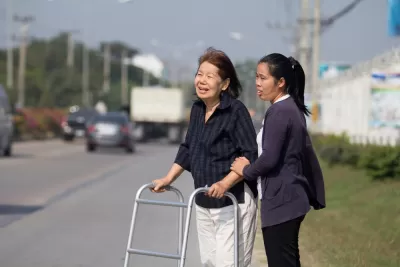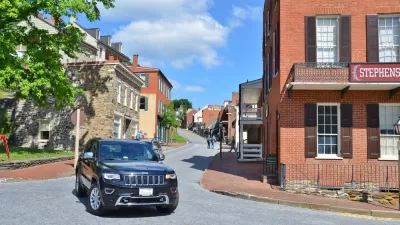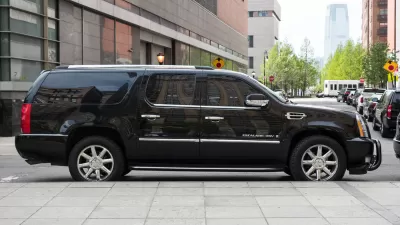Bigger cars and an older population means a growing number of Americans die while crossing the street, and the country is just getting older.

There are 70 million Baby Boomers in the United States, which is about a fourth of the county's population. "By 2020, 56 million of them will be over 65 years old," Lloyd Alter writes in Mother Nature Network. This is concerning, because pedestrian fatalities in America are already climbing, and Americans are aging into more vulnerability. "Older people are dying in the streets because their bodies are more fragile, yet the mix of vehicles on the street gets deadlier every year as more people drive SUVs and pickup trucks that have front ends that are like vertical walls of steel," Alter writes.
"The usual thing these days is to blame the pedestrians for distracted walking," Alter complains. But the elderly represent a disproportionate share of the pedestrians being killed and they are less likely to use a cellphone while walking than their younger counterparts.
In terms of solutions, Alter proposes slowing down streets, not with lower posted speed limits, but actual design to slow traffic by adding road diets, bump-outs, and narrowed lanes, as well as regulating car makers so that they build safer cars like those already in place in Europe. Alter also suggests mobilizing pedestrians as a political force.
FULL STORY: It's time to take back the streets and make them safe for walking

Planetizen Federal Action Tracker
A weekly monitor of how Trump’s orders and actions are impacting planners and planning in America.

Restaurant Patios Were a Pandemic Win — Why Were They so Hard to Keep?
Social distancing requirements and changes in travel patterns prompted cities to pilot new uses for street and sidewalk space. Then it got complicated.

Map: Where Senate Republicans Want to Sell Your Public Lands
For public land advocates, the Senate Republicans’ proposal to sell millions of acres of public land in the West is “the biggest fight of their careers.”

Maui's Vacation Rental Debate Turns Ugly
Verbal attacks, misinformation campaigns and fistfights plague a high-stakes debate to convert thousands of vacation rentals into long-term housing.

San Francisco Suspends Traffic Calming Amidst Record Deaths
Citing “a challenging fiscal landscape,” the city will cease the program on the heels of 42 traffic deaths, including 24 pedestrians.

California Homeless Arrests, Citations Spike After Ruling
An investigation reveals that anti-homeless actions increased up to 500% after Grants Pass v. Johnson — even in cities claiming no policy change.
Urban Design for Planners 1: Software Tools
This six-course series explores essential urban design concepts using open source software and equips planners with the tools they need to participate fully in the urban design process.
Planning for Universal Design
Learn the tools for implementing Universal Design in planning regulations.
Heyer Gruel & Associates PA
JM Goldson LLC
Custer County Colorado
City of Camden Redevelopment Agency
City of Astoria
Transportation Research & Education Center (TREC) at Portland State University
Camden Redevelopment Agency
City of Claremont
Municipality of Princeton (NJ)




























